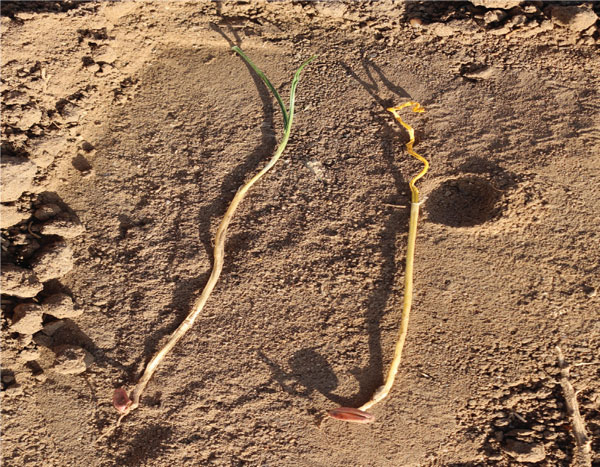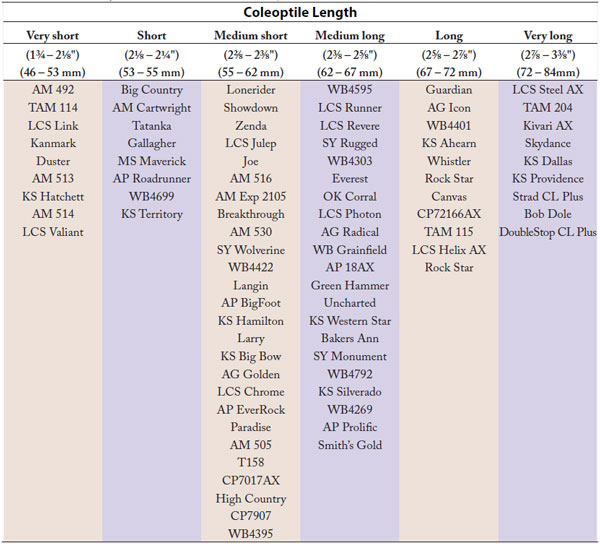A new publication is now available in the Wheat Rx series. Wheat Rx is a partnership between Kansas Wheat and K-State Research and Extension to disseminate the latest research recommendations for high-yielding and high-quality wheat to Kansas wheat farmers. This latest publication examines the coleoptiles lengths of many Kansas wheat varieties. Wheat varieties with long coleoptiles are more likely to emerge when planted deep enough to reach soil moisture from past rainfall. This article summarizes information from the publication. The full publication, MF3612 Coleoptile Length of Winter Wheat Varieties 2022, is available online at: https://bookstore.ksre.ksu.edu/pubs/MF3612.pdf.
Coleoptile Length
Once a wheat seed starts to absorb water, the seminal roots are the first developmental structure to emerge. After the seminal roots, the coleoptile develops. The coleoptile is a rigid protective structure that covers the emerging shoot to aid it in reaching the soil surface (Figure 1). The coleoptile usually continues to elongate until it breaks the soil surface and reaches sunlight. At this point, it stops growing and the first true leaf emerges through it.
If the seed is sown deeper than the coleoptile’s length, the coleoptile is not able to emerge through the soil surface, and consequently, the first true leaf emerges below ground. This causes the first true leaf to take on an accordion-like appearance and the wheat plant typically becomes yellow and dies (Figure 1). To avoid this situation, wheat should never be sown deeper than the coleoptile length of the chosen variety.

Figure 1. Deep-sown wheat demonstrating the potential for coleoptile elongation (yellow arrows point to the end of the coleoptile). In the left, the coleoptile was able to reach the soil surface and the first true leaf emerged above ground, therefore showing normal early development. In the right, the coleoptile’s maximum length was shorter than the sowing depth, resulting in the emergence of the first true leaf below the ground level. As the first true leaf does not have the strength to continue pushing upwards when it emerges below ground, it takes on an accordion-like shape and becomes yellow, leading to plant death. Photo by Romulo Lollato, K-State Research and Extension.
In dryland environments typical of western Kansas and eastern Colorado, wheat is often sown on soil moisture accumulated in the last summer rainfall events, which requires growers to sow deep in order to reach moisture. This is less of a concern in central Kansas during most years, where growers can achieve good stands by relying on fall precipitation for good topsoil moisture at sowing time.
To achieve good crop establishment on deep-placed seed, long coleoptile varieties are essential. An additional concern in these regions is that many growers sow their wheat early for grazing, which places sowing time during warmer soil temperatures – which further reduces the coleoptile length.
Depending on variety, this reduction in coleoptile length due to high temperatures may be as much as 60%. For example, a variety that has a 27/8-inch (75 mm) coleoptile at 60 degrees Fahrenheit could have a 15/8-inch (40 mm) coleoptile at 80 degrees Fahrenheit soil temperature. While different varieties have different sensitivities to warm soil conditions, selecting varieties with longer-than-average coleoptiles could help prevent emergence issues under these conditions.
To help guide variety selection for deep sowing, this publication provides growers with an estimate of average coleoptile length of different winter wheat varieties common to Kansas and the Great Plains.
Description of Procedures
This study was performed under controlled conditions, which differ from field conditions but provide a fair comparison among the different wheat varieties’ potential coleoptile lengths.
Seeds were tested from all varieties entered in the 2022 Kansas State University winter wheat variety performance tests, as well as from other seed sources used for agronomic studies during the same crop year. Sixty seeds of each variety were tested. Variety randomization ensured that the experiment was conducted in a randomized complete block design and each variety occurred one time, and that the coleoptile length was measured in 40 plants per variety.
Coleoptile Length of Winter Wheat Varieties
Results from this controlled-environment experiment are shown on Table 1. The longest coleoptile varieties ranged from 23/4 to 31/4 inches (72 to 84 mm) and included LCS Steel AX, TAM 204, Kivari AX, Skydance, KS Dallas, KS Providence, Strad CL Plus, Bob Dole, and DoubleStop CL Plus.
Several variety options were also included in the second and third longest coleoptile groups (namely “Long” and “Medium-long” in Table 1) and could potentially be good options for deep sowing in western environments, as their coleoptile length ranged from 23/8 to 23/4 inches. Alternatively, many varieties had relatively short coleoptiles, falling in the two lowest groups (less than 21/8 inches (55 mm)). These varieties included: AM492, Big Country, TAM 114, AM Cartwright, LCS Link, Tatanka, Kanmark, Gallagher, Duster, MS Maverick, AM 513, AP RoadRunner, KS Hatchett, WB4699, AM514, KS Territory, and LCS Valiant. Use caution when sowing these varieties in deeper than average conditions; and note that seed purity and vigor can influence coleoptile length. Wheat seeds were submitted for testing in the official wheat variety testing program at Kansas State University, there was no effort to ensure all seeds met minimum purity or vigor requirements.
Table 1. Wheat variety grouping based on coleoptile length measured in a controlled environment experiment during the 2022 winter wheat season in Kansas. A total of 40 coleoptiles were measured per variety.

For more information
Dual-purpose Wheat: Management for Forage and Grain Production. K-State Research and Extension publication MF3375
Factors Affecting Wheat Germination and Stand Establishment in Hot Soils, Oklahoma State University Extension Publication PSS-2256.
Wheat Seedling Emergence from Deep Planting Depths and Its Relationship with Coleoptile Length. PLoS One 2013; 8(9): e73314 doi: 10.1371/journal.pone.0073314
Wheat Grain Yield Response to Seed Cleaning and Seed Treatment as Affected by Seeding Rate During the 2018–2019 Growing Season in Kansas. Kansas Agric. Exp. Stat. Res. Report 6(5). 2020.
Wheat Grain Yield Response to Seed Cleaning and Seed Treatment as Affected by Seeding Rate During the 2019-2020 Growing Season in Kansas. Kansas Agric. Exp. Stat. Res. Report 7(5). 2021.
Wheat Grain Yield Response to Seed Cleaning and Seed Treatment as Affected by Seeding Rate During the 2020-2021 Growing Season in Kansas. Kansas Agric. Exp. Stat. Res. Report 8(4). 2022.
Romulo Lollato, Extension Wheat and Forage Specialist
lollato@ksu.edu
Luiz Otavio Pradella, Graduate student
Jorge Romero Soler, Visiting Scientist
Jane Lingenfelser, Assistant Agronomist
Erick DeWolf, Wheat Pathologist
Kelsey Andersen Onofre, Extension Wheat Pathologist
Tags: wheat Wheat Rx wheat variety coleoptile